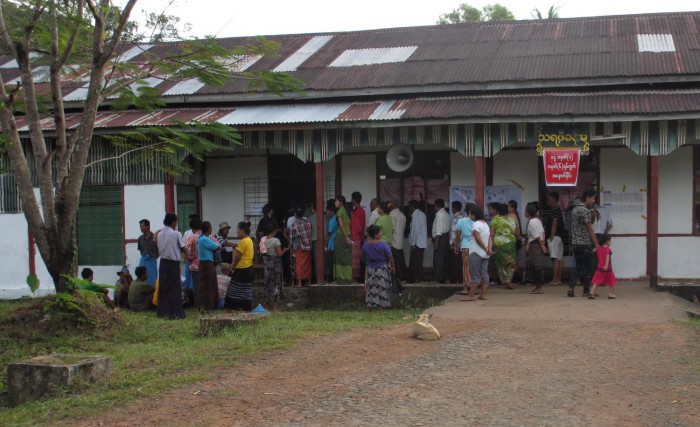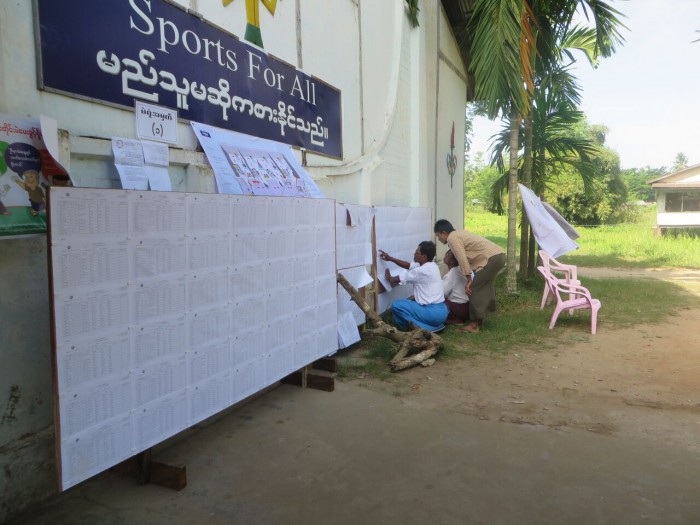12th November 2015 Burma
8th November: A day in the life of a Burma elections observer

5.45am – voting opens
The polling station manager lifted the empty ballot box over her head to show us the party candidates, other polling station volunteers and us observers that the boxes were empty. With just a few minutes to go, we were about to witness history in the making with the opening of the polls for Burma’s first credible elections in many decades.
Already people were queuing outside; excited and enthusiastic to choose their next government. The 4am wake up and the drive down dusty roads in the dark was already forgotten as the clock ticked down to the 6am opening. Seeing the first people exiting the polling station hold up their little fingers to show the indelible ink that proved they had voted was a proud moment for me.

I had cast my vote in advance in order to be able to undertake my duties as an election observer. One of 25 British Embassy teams, me and two colleagues travelled to Kawkareik, a largely rural state in the south east of Burma. Our job was to observe the balloting, vote counting and tabulation on election day. International election observation is now common around the world and specially trained observers are there just to watch; they cannot become involved in the process but their presence alone does make it harder for the results to be manipulated without being found out.
11am – observing polls
By now we were on our third polling station of the day, a military barracks. There were nearly 250 voters on the list and in contrast to the first polling station, it was quite quiet already. A school inside the barracks had been taken over for the day and military personnel and their families were casting their votes.
We were not the only election observers out and about across the country. The US, Australia, Canada and the European Union (EU) also had teams. The EU deployed an election observer mission of 100 short and long term observers and the Department for International Development (DFID) funded the training of 5,000 Burmese election observers.
In addition, the UK proved £2.7 million for the International Foundation for Electoral Systems (IFES) to provide technical assistance to the Union Election Commission (UEC). IFES has helped the UEC improve the voters’ lists with nearly six million corrections and hundred of thousands of voters added. It has supported the UEC to train polling station staff and to develop procedures for the accreditation of nationwide international and domestic observation for the first time in Burma’s history. We also provided the indelible ink to prevent double voting on the day along with education activities on the voting process and voters’ rights.

4pm – voting closes
Polling stations across the country closed their doors. Earlier concerns about big queues of people still waiting to vote proved to be unfounded as it seems that many people turned out in the morning, with activity tailing off as the day went on. However, if there was anyone queuing at this point they would have still been able to cast their vote.
So now the polling station staff had the job of undertaking the count. With election observers, party candidates and witness present each ballot was opened and the results were tallied. While members of the public weren’t allowed in, small crowds formed at some polling stations as the people looked in through the windows.
Each ballot was opened, showed to the group and tallied while any invalid votes, such as if the stamp went over more than one box, were noted. Each person casts a ballot for the upper, lower and state parliaments and those who are eligible also get to vote in the ethnic seats. As a result, it took nearly four hours to count all the votes.

9pm – tabulation centre
Our day wasn’t over yet as we still had to follow the ballot boxes to the tabulation centre; a fifteen minute drive down more bumpy and dark roads. Here results from polling stations across the area were aggregated. At this point, just nine polling stations had been tallied and we were in for a long night as we waited for the 82 others to come in. Each polling station manager delivered their boxes and handed over the paperwork; many of them knowing they’d be returning to their classrooms tomorrow but this time back to their usual capacity as teachers.
12 midnight – the end of a long day!
We called it a day at midnight but the tabulation work was still on going. I was exhausted but also elated from having seen so many people who were happy to have played their part in the democratic process and have played a small part myself in making it happen.